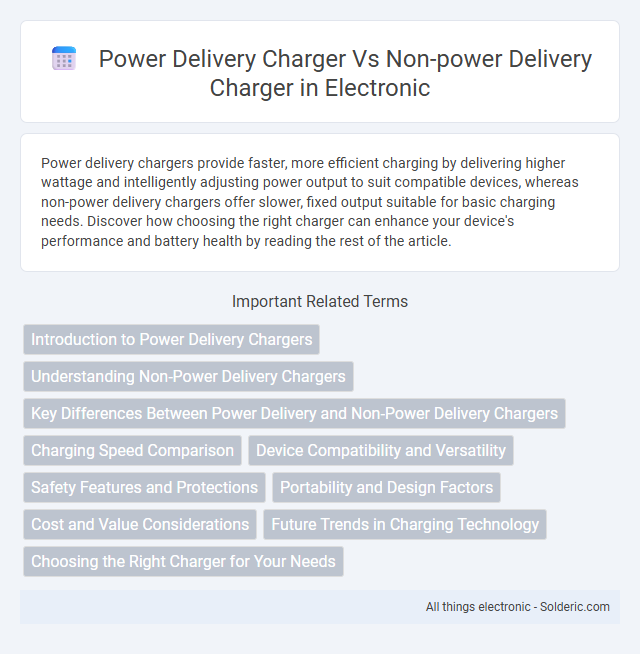Power delivery chargers provide faster, more efficient charging by delivering higher wattage and intelligently adjusting power output to suit compatible devices, whereas non-power delivery chargers offer slower, fixed output suitable for basic charging needs. Discover how choosing the right charger can enhance your device's performance and battery health by reading the rest of the article.
Comparison Table
| Feature | Power Delivery (PD) Charger | Non-Power Delivery Charger |
|---|---|---|
| Charging Technology | USB Power Delivery (USB PD) Protocol | Standard USB Charging (e.g., USB-A, USB-B) |
| Charging Speed | Fast charging up to 100W depending on device | Slower, typically 5W to 12W |
| Compatibility | Broad compatibility with modern smartphones, laptops, tablets | Limited to basic devices, mostly older or lower power |
| Power Negotiation | Dynamic voltage and current negotiation for optimized charging | No power negotiation, fixed output voltage and current |
| Connector Types | USB-C commonly used | USB-A, USB-B, Micro USB, others |
| Device Protection | Advanced protection: overvoltage, overcurrent, temperature | Basic protection only |
| Use Cases | Charging high-power devices: laptops, fast-charge phones, tablets | Charging low-power devices: older phones, accessories |
| Price Range | Higher cost due to technology and performance | Lower cost, simpler design |
Introduction to Power Delivery Chargers
Power Delivery (PD) chargers provide faster and more efficient charging by delivering higher wattage through USB-C connections, allowing compatible devices to charge significantly quicker than standard chargers. Unlike non-PD chargers, which supply a fixed output, PD chargers dynamically adjust power levels based on your device's needs, optimizing safety and speed. This technology supports a wide range of devices, from smartphones and tablets to laptops, enhancing overall charging versatility and convenience.
Understanding Non-Power Delivery Chargers
Non-Power Delivery chargers provide standard charging capabilities with fixed voltage and current levels, typically limited to 5V at 2A or lower, resulting in slower charge times compared to Power Delivery (PD) chargers. Unlike PD chargers that dynamically adjust voltage and current to optimize charging speed and efficiency for compatible devices, non-PD chargers deliver consistent power output without negotiation features. If you rely on devices that support fast charging, using a non-Power Delivery charger may lead to longer charging durations and reduced overall performance.
Key Differences Between Power Delivery and Non-Power Delivery Chargers
Power Delivery (PD) chargers support faster and more efficient charging by providing higher wattage and dynamically adjusting voltage and current, making them ideal for smartphones, laptops, and tablets. Non-Power Delivery chargers operate at fixed voltages and lower power levels, often resulting in slower charging speeds and less compatibility with high-powered devices. Your choice between the two impacts charging speed, device compatibility, and overall efficiency, especially if you frequently charge multiple or power-hungry gadgets.
Charging Speed Comparison
Power delivery (PD) chargers significantly outperform non-PD chargers in charging speed due to their ability to deliver variable and higher wattages, often up to 100W, optimizing power output based on device requirements. Non-PD chargers typically provide fixed, lower wattages, such as 5W or 12W, resulting in longer charging times for modern smartphones and laptops. Devices equipped with USB-C Power Delivery standards can reach 50% charge in approximately 30 minutes, while non-PD chargers may take several hours for similar battery levels.
Device Compatibility and Versatility
Power delivery chargers support a wide range of devices including smartphones, laptops, tablets, and gaming consoles by providing variable voltage and current levels for efficient charging. Non-power delivery chargers are limited to fixed voltage outputs, restricting compatibility primarily to smaller devices like smartphones and basic accessories. Their limited versatility often results in slower charging speeds and potential incompatibility with high-power devices.
Safety Features and Protections
Power delivery (PD) chargers incorporate advanced safety features such as over-voltage protection, over-current protection, and temperature control to prevent damage to devices and ensure safe charging. Non-power delivery chargers typically offer basic protection but lack the intelligent communication protocols that dynamically adjust power output, increasing the risk of overheating or short circuits. PD chargers' compliance with USB Power Delivery standards enhances user safety by optimizing voltage and current flow based on the connected device's needs.
Portability and Design Factors
Power delivery chargers are typically more compact and lightweight, making them highly portable for on-the-go use and ideal for modern, slim devices. Non-power delivery chargers often have bulkier designs due to larger transformers and limited power efficiency, reducing convenience in travel and everyday carry. Choosing a power delivery charger enhances your portability experience with sleek, efficient designs that support fast charging without compromising portability.
Cost and Value Considerations
Power delivery chargers generally come at a higher initial cost compared to non-power delivery chargers but offer superior charging speeds and broader device compatibility, providing greater long-term value especially for users with multiple devices. While non-power delivery chargers are more affordable upfront, they often lack efficient energy transfer and fast charging capabilities, potentially leading to longer charging times and less convenience. Investing in a power delivery charger enhances overall charging efficiency and future-proofs device compatibility, making it cost-effective despite the higher price point.
Future Trends in Charging Technology
Power delivery chargers support higher wattages and faster charging times, making them essential for future devices requiring rapid energy transfer and compatibility with evolving USB-C standards. Non-power delivery chargers lag in efficiency and adaptability, limiting your ability to charge next-generation smartphones, laptops, and tablets swiftly. Investing in power delivery technology ensures your charging setup remains relevant as demand for quicker, safer, and more intelligent power delivery solutions grows.
Choosing the Right Charger for Your Needs
Power delivery (PD) chargers offer faster and more efficient charging by delivering optimal wattage tailored to your device, supporting a wide range of electronics from smartphones to laptops. Non-power delivery chargers lack this adaptive technology, resulting in slower charging speeds and limited compatibility with high-power devices. Choosing the right charger depends on your device requirements and charging speed preferences to ensure maximum performance and safety.
Power delivery charger vs non-power delivery charger Infographic

 solderic.com
solderic.com